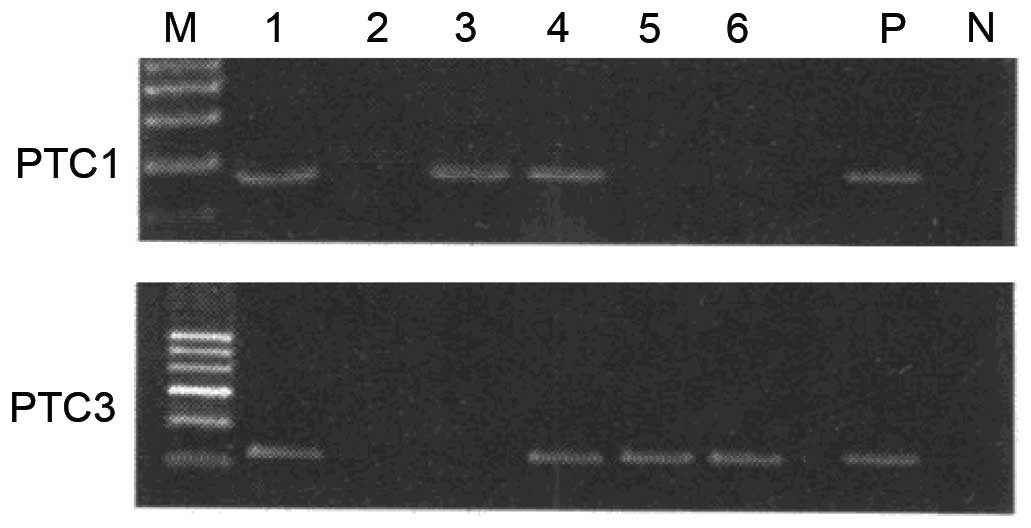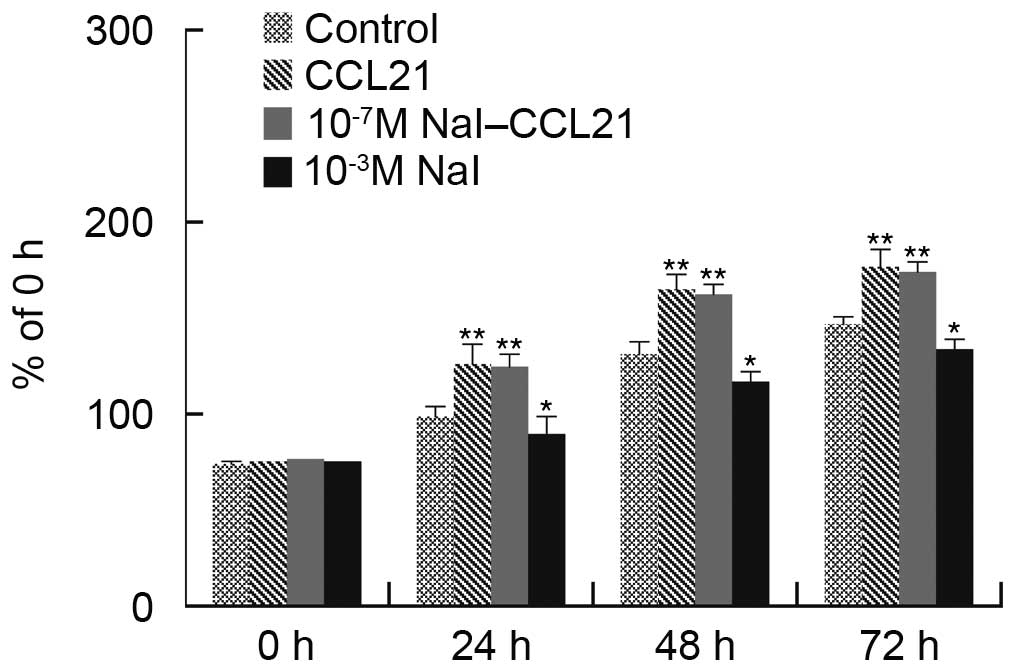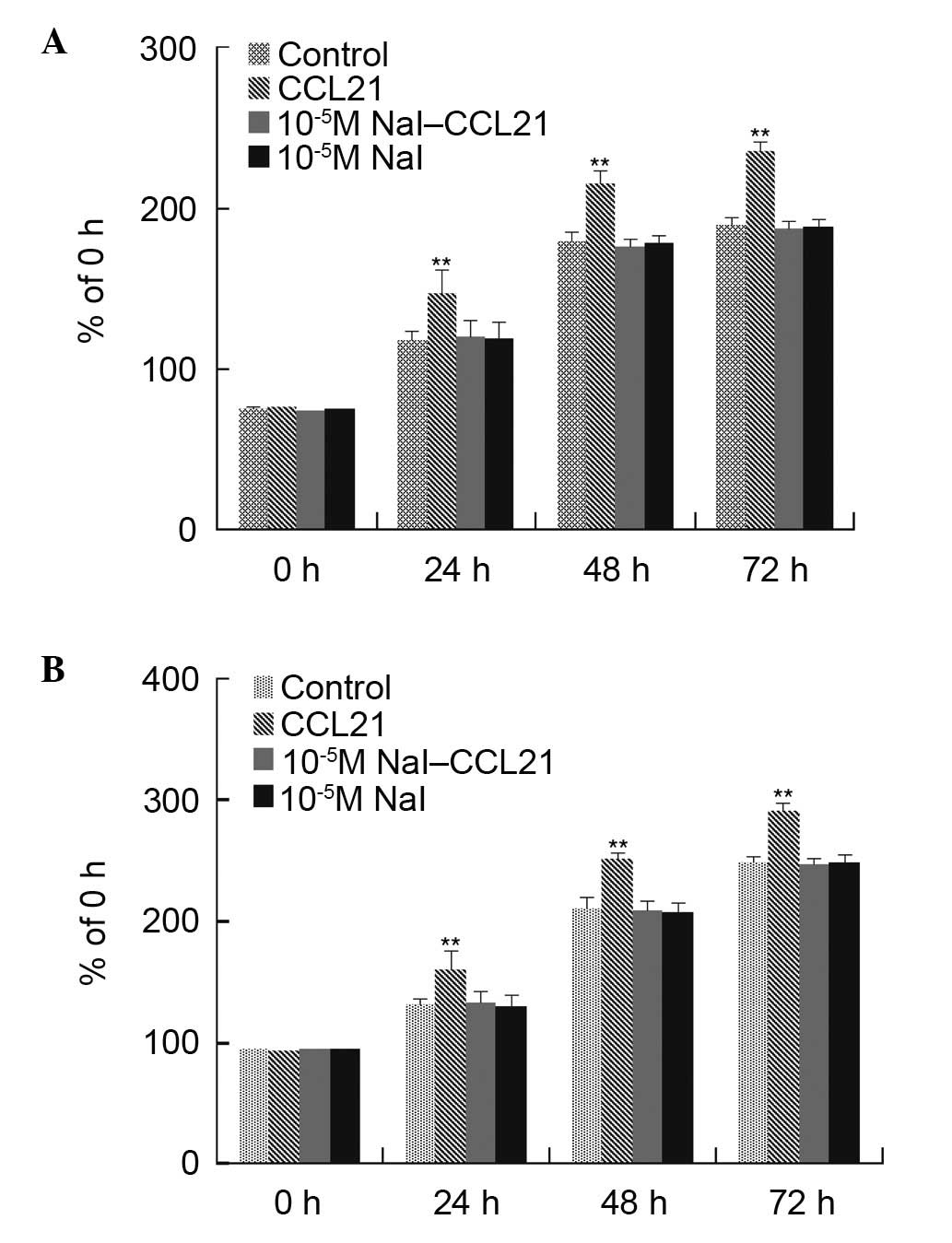|
1
|
Mousavi Z, Dourandish L, Rokni H, Sadeghi
R and Rasoul Zakavi S: Effects of short-term metformin therapy
associated with levothyroxine dose decrement on TSH and thyroid
hormone levels in patients with thyroid cancer. Minerva Endocrinol.
39:59–65. 2014.PubMed/NCBI
|
|
2
|
Rossi M, Buratto M, Tagliati F, Rossi R,
Lupo S, Trasforini G, Lanza G, Franceschetti P, Bruni S, Degli
Uberti E and Zatelli MC: Relevance of BRAF(V600E) mutation testing
versus RAS point mutations and RET/PTC rearrangements evaluation in
the diagnosis of thyroid cancer. Thyroid. 25:221–228. 2015.
View Article : Google Scholar :
|
|
3
|
Knauf JA, Kuroda H, Basu S and Fagin JA:
RET/PTC-induced dedifferentiation of thyroid cells is mediated
through Y1062 signaling through SHC-RAS-MAP kinase. Oncogene.
22:4406–4412. 2003. View Article : Google Scholar : PubMed/NCBI
|
|
4
|
Vivero M, Kraft S and Barletta JA: Risk
stratification of follicular variant of papillary thyroid
carcinoma. Thyroid. 23:273–279. 2013. View Article : Google Scholar
|
|
5
|
Fiore AP, Fuziwara CS and Kimura ET: High
iodine concentration attenuates RET/PTC3 oncogene activation in
thyroid follicular cells. Thyroid. 19:1249–1256. 2009. View Article : Google Scholar : PubMed/NCBI
|
|
6
|
Shakhtarin VV, Tsyb AF, Stepanenko VF,
Orlov MY, Kopecky KJ and Davis S: Iodine deficiency, radiation
dose, and the risk of thyroid cancer among children and adolescents
in the Bryansk region of Russia following the Chernobyl power
station accident. Int J Epidemiol. 32:584–591. 2003. View Article : Google Scholar : PubMed/NCBI
|
|
7
|
Zhu Z, Ciampi R, Nikiforova MN, Gandhi M
and Nikiforov YE: Prevalence of RET/PTC rearrangements in thyroid
papillary carcinomas: Effects of the detection methods and genetic
heterogeneity. J Clin Endocrinol Metab. 91:3603–3610. 2006.
View Article : Google Scholar : PubMed/NCBI
|
|
8
|
Marotta V, Guerra A, Sapio MR and Vitale
M: RET/PTC rearrangement in benign and malignant thyroid diseases:
A clinical standpoint. Eur J Endocrinol. 165:499–507. 2011.
View Article : Google Scholar : PubMed/NCBI
|
|
9
|
Santoro M, Melillo RM, Grieco M,
Berlingieri MT, Vecchio G and Fusco A: The TRK and RET tyrosine
kinase oncogenes cooperate with ras in the neoplastic
transformation of a rat thyroid epithelial cell line. Cell Growth
Differ. 4:77–84. 1993.PubMed/NCBI
|
|
10
|
Colato C, Vicentini C, Cantara S, Pedron
S, Brazzarola P, Marchetti I, Di Coscio G, Chilosi M, Brunelli M,
Pacini F and Ferdeghini M: Break-apart interphase fluorescence in
situ hybridization assay in papillary thyroid carcinoma: On the
road to optimizing the cut-off level for RET/PTC rearrangements.
Eur J Endocrinol. 172:571–582. 2015. View Article : Google Scholar : PubMed/NCBI
|
|
11
|
Romei C and Elisei R: RET/PTC
translocations and clinicopathological features in human papillary
thyroid carcinoma. Front Endocrinol (Lausanne). 3:542012.
|
|
12
|
Zlotnik A and Yoshie O: Chemokines: A new
classification system and their role in immunity. Immunity.
12:121–127. 2000. View Article : Google Scholar : PubMed/NCBI
|
|
13
|
Takanami I: Overexpression of CCR7 mRNA in
nonsmall cell lung cancer: Correlation with lymph node metastasis.
Int J Cancer. 105:186–189. 2003. View Article : Google Scholar : PubMed/NCBI
|
|
14
|
Wang J, Xi L, Hunt JL, Gooding W,
Whiteside TL, Chen Z, Godfrey TE and Ferris RL: Expression pattern
of chemokine receptor 6 (CCR6) and CCR7 in squamous cell carcinoma
of the head and neck identifies a novel metastatic phenotype.
Cancer Research. 64:1861–1866. 2004. View Article : Google Scholar : PubMed/NCBI
|
|
15
|
Brest P, Lassalle S, Hofman V, Bordone O,
Gavric Tanga V, Bonnetaud C, Moreilhon C, Rios G, Santini J, Barbry
P, et al: MiR-129-5p is required for histone deacetylase
inhibitor-induced cell death in thyroid cancer cells. Endocr Relat
Cancer. 18:711–719. 2011. View Article : Google Scholar : PubMed/NCBI
|
|
16
|
Zhang Z, Liu ZB, Ren WM, Ye XG and Zhang
YY: The miR-200 family regulates the epithelial-mesenchymal
transition induced by EGF/EGFR in anaplastic thyroid cancer cells.
Int J Mol Med. 30:856–862. 2012.PubMed/NCBI
|
|
17
|
Sancho M, Vieira JM, Casalou C, Mesquita
M, Pereira T, Cavaco BM, Dias S and Leite V: Expression and
function of the chemokine receptor CCR7 in thyroid carcinomas. J
Endocrinol. 191:229–238. 2006. View Article : Google Scholar : PubMed/NCBI
|
|
18
|
Xu Y, Liu L, Qiu X, Jiang L, Huang B, Li
H, Li Z, Luo W and Wang E: CCL21/CCR7 promotes G2/M phase
progression via the ERK pathway in human non-small cell lung cancer
cells. PLoS One. 6:e211192011. View Article : Google Scholar : PubMed/NCBI
|
|
19
|
Johnson GL and Lapadat R:
Mitogen-activated protein kinase pathways mediated by ERK, JNK, and
p38 protein kinases. Science. 298:1911–1912. 2002. View Article : Google Scholar : PubMed/NCBI
|
|
20
|
Chang L and Karin M: Mammalian MAP kinase
signalling cascades. Nature. 410:37–40. 2001. View Article : Google Scholar : PubMed/NCBI
|
|
21
|
Nigg EA: Cyclin-dependent protein kinases:
Key regulators of the eukaryotic cell cycle. Bioessays. 17:471–480.
1995. View Article : Google Scholar : PubMed/NCBI
|
|
22
|
Girard F, Strausfeld U, Fernandez A and
Lamb NJ: Cyclin A is required for the onset of DNA replication in
mammalianfi broblasts. Cell. 67:1169–1179. 1991. View Article : Google Scholar : PubMed/NCBI
|














